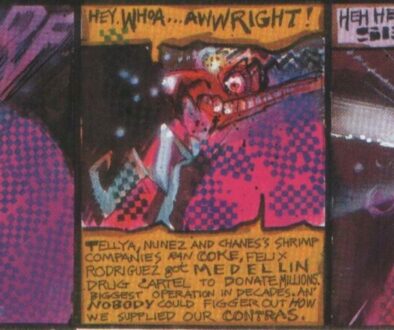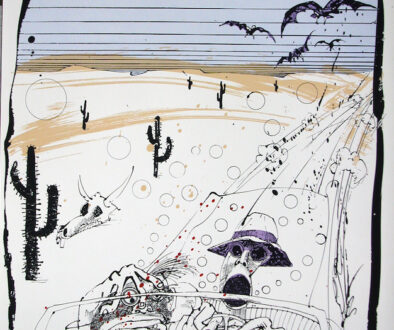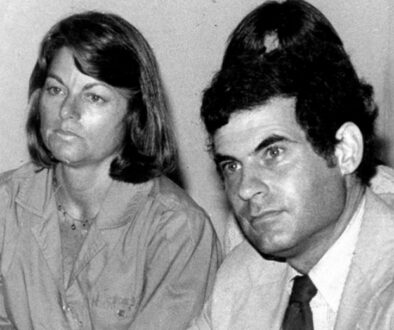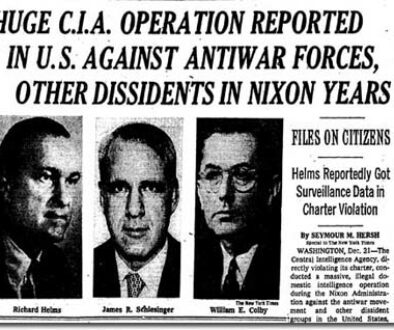Through Powdered Teeth (The Last War in Albion Part 77: Valerie)
Last War in Albion will now be running on Thursdays.
This is the fifth of fifteen parts of The Last War in Albion Chapter Nine, focusing on Alan Moore’s work on V for Vendetta for Warrior (in effect, Books One and Two of the DC Comics collection). An omnibus of all fifteen parts can be purchased at Smashwords. If you purchased serialization via the Kickstarter, check your Kickstarter messages for a free download code.
The stories discussed in this chapter are currently available in a collected edition, along with the eventual completion of the story. UK-based readers can buy it here.
 |
| Figure 584: The title character makes a fleeting appearance in Book Two, tacitly answering Gordon’s question. (Written by Alan Moore, art by David Lloyd, from “Variety” in Warrior #19, 1984) |
 |
| Figure 585: The beginning of Valerie’s note. (Written by Alan Moore, art by David Lloyd, from “Vermin” in Warrior #24, 1984) |
 |
| Figure 586: Evey cowers within her cell. (Written by Alan Moore, art by David Lloyd, from “Valerie” in Warrior #25, 1984) |
 |
| Figure 587: Evey being tortured. (Written by Alan Moore, art by David Lloyd, from “Valerie” in Warrior #25, 1984) |
 |
| Figure 588: Valerie caresses her first girlfriend’s hand. (Written by Alan Moore, art by Tony Weare, from “Valerie” in Warrior #25, 1984) |
only autobiography I will ever write and oh god I’m writing it on toilet paper,” a harrowing set of details that reinforces the sense of routine depravity implicit in this regime of pointless and repetitive torture, such that the single interrogation depicted within it stands in for countless others before and after.
 |
| Figure 589: “Valerie” featured art from Tony Weare, whose scratchier style was a contrast with David Lloyd’s. (Written by Alan Moore, from Warrior #25, 1984) |
She tells of coming out to her parents at the age of nineteen when she “took a girl called Christine home to meet my parents.” Weare, whose scratchier and looser style results in somewhat more expressive faces than the eye-bulging grotesques of David Lloyd, depicts the shocked reactions of her parents, and Valerie confirms
that “my mother said I broke her heart. But,” she continues, as Weare draws a landscape shot of Valerie standing at a rail, looking over a pond, with roses growing in the near ground, “it was my integrity that was important. Is that so selfish? It sells for so little. But it’s all we have left in this place. It is the very last inch of us…” she continues, and then the final panel returns to David Lloyd’s art, picking up in the exact instant that the first page left off, with Evey’s head plunged into the water, as the narration concludes that “within that inch we are free.”
 |
| Figure 590: Evey’s head is violently pulled back above water, interrupting her recollection of Valerie’s letter. (Written by Alan Moore, art by David Lloyd, from “Valerie” in Warrior #25, 1984) |
 |
| Figure 591: As Evey’s head is shoved back under the water, her recollections resume. (Written by Alan Moore, art by David Lloyd, from “Valerie” in Warrior #25, 1984) |
 |
| Figure 592: Valerie and Ruth hold each other as the war breaks out, with roses in the foreground. (Written by Alan Moore, art by Tony Weare, from “Valerie” in Warrior #25, 1984) |
And so the action cuts back to Valerie’s story, with another page of her autobiography presented as text, telling about how “in 1981 I played Dandini in Cinderella. My first rep work. The world was strange and rusting and busy with invisible crowds behind the hot lights and all that breathless glamour.” She talks of her early forrays into London’s gay scene, and her frustrations with and sense of alienation from it. “So many of them just wanted to be gay. It was their life. Their ambition. All they talked about. And I wanted more than that,” she says. In 1986, she says, she got a role in a film called The Salt Flats, where she met a woman named Ruth and began an affair. “We lived together,” she says, “and on Valentine’s Day she sent me roses, and oh god we had so much. Those were the best years of my life.”
 |
| Figure 593: The marching Norsefire crowd transitions to Evey’s torture. (Written by Alan Moore, art by Tony Weare and David Lloyd, from “Valerie” in Warrior #25, 1984) |
This section, for attentive readers, offers a number of clues as to what is happening. The Salt Flats is the film that V stole a poster for back in Chapter Two of Book Two, and the image of roses has throughout the book been closely linked with V, who left flowers besides his early victims, and who spent his time in Larkhill gardening and growing roses. The significance of this is further emphasized by the next panel, featuring Valerie and Ruth shown from behind, cuddling on a sofa and watching the news, with three roses in the foreground. “In 1988 there was the war,” Valerie narrates, “and after that there were no more roses. Not for anybody,” the final two panels of the page showing a massive parade of men in Norsefire uniforms, marching left to right across the panel, such that the final panel, another shot of the guard drowning Evey, serves as the symbolic head of their pack.
 |
| Figure 594: Evey’s torture is contrasted with the narration of Valerie’s letter detailing her own torture. (Written by Alan Moore, art by David Lloyd, from “Valerie” in Warrior #25, 1984) |
The fifth page returns to the scenes of Evey’s torture, as she’s pulled out of the bowl, blindfolded, and shoved back into her cell. But the text continues Valerie’s story, describing how “in 1992, after the take-over, they started rounding up the gays. They took Ruth while she was out looking for food. Why are they so frightened of us,” she asks. As Evey is tortured and shoved around, Valerie talks about how Ruth was tortured into giving up Valerie’s name and claiming she had seduced her. “I didn’t blame her,” Valerie insists. “But she did. She killed herself in her cell. She couldn’t live with betraying me. With giving up that last inch.” Valerie tells of her own capture – of how “they shaved off my hair. They held my head down a toilet bowl and told jokes about lesbians. They brought me here and gave me drugs. I can’t feel my tongue anymore. I can’t speak. The other gay woman here, Rita, died two weeks ago.”
 |
| Figure 595: Evey, abandoned once again in her cell. (Written by Alan Moore, art by David Lloyd, from “Valerie” in Warrior #25, 1984) |
This last point once again serves as a clue for attentive readers, being the second mention of Rita within V for Vendetta. The previous one came up at the end of Book One, as Finch is reading Adam Susan excerpts from Dr. Surridge’s diary of her time at Larkhill, which include the off-handed comment that “Rita Boyd, the Lesbian, died at tea-time. During the autopsy we found four tiny festigial fingers forming within the calf of her leg. Given that V burnt Larkhill to the ground in his escape, it is impossible that Valerie’s toilet paper autobiography could have survived, or that Evey could actually be imprisoned there. But this clue is subtle and overwhelmed by the images of Evey’s degradation and the stark, awful blacks of the cell she is shoved back into. “It is strange that my life should end in such a terrible place,” Valerie’s narration continues, “but for three years I had roses and I apologised to nobody. I shall die here. Every inch of me shall perish.” The page ends with a medium shot of Evey, contorted in pain within her darkened cell, as Valerie’s narration continues: “except one.”
 |
| Figure 596: Evey sits in her cell, reading Valerie’s letter, alongside reprises of earlier panels. (Written by Alan Moore, art by Tony Weare and David Lloyd, from “Valerie” in Warrior #25, 1984) |
After these five pages alternating between illustrating Valerie’s life and illustrating the horrors of Evey’s captivity, the chapter concludes with a final page that alternates between them. “An inch,” Valerie writes, over a reprise of the panel of Valerie and Sara’s hands touching in Miss Watson’s class. “It’s small and it’s fragile and it’s the only thing in the world that’s worth having. We must never lose it, or sell it, or give it away. We must never let them take it from us,” she continues, over a small panel of Evey’s weary and exhausted face reading the letter yet again.
 |
| Figure 597: Evey kisses the bottom of the letter, where Valerie left a single X. (Written by Alan Moore, art by David Lloyd, from “Valerie” in Warrior #25, 1984) |
This is followed by a reprise of the image of Valerie standing by a pond watching the birds, a rosebush behind her, as her narration continues: “I don’t know who you are, or whether you’re a man or woman. I may never see you. I will never hug you or cry with you or get drunk with you. But I love you. I hope that you escape this place,” she writes, as the art switches back to Evey, now in medium shot, sitting on her wooden cot, the toilet paper scroll hanging from her hands, an isolated and haggard figure in her chiaroscuro cell. “I hope that the world turns and that things get better, and that one day people have roses again.” Valerie makes her final appearance in the next panel, a close-up of her, still standing at the rail, watching the ducks. “I wish I could kiss you,” she writes, and then signs her letter, “Valerie,” the text positioned in the top-right corner of the panel. In the bottom-right, a final note – a single “x” to represent the kiss she can never give to the reader she will never know she has.
 |
| Figure 598: Evey’s last inch. (Written by Alan Moore, art by David Lloyd, from “Valerie” in Warrior #25, 1984) |
The art cuts back to Evey for the final row of panels, her face in shadow, a single tear visible, the narration returning to her instead of simply her quoting Valerie. “I know every inch of this cell,” she thinks, as she holds the scrap of toilet paper up, her face shrunken and lined with wrinkles that should be impossible for a woman who is only sixteen years old, and kisses it softly on the x. “This cell knows every inch of me.” And a final panel, her eyes and nose, weathered, single tear still suspended on her face, the edges of it simply fading out to the stark and infinite whiteness of the page.





January 1, 2015 @ 6:24 pm
This really is the sequence that takes V for Vendetta from being just a really solid, thought-provoking story of resistance to being one of a handful of definitive examples, up there with 1984 and The Handmaid's Tale. It is at once so moving, so beautiful that words fail at describing it, and so intensely cruel once you realize who is torturing her and the lengths they're going to.
January 1, 2015 @ 6:40 pm
Was glad to see they nailed this sequence in the film – I though they'd excise it, but it was one of it's highlights for me. The person I saw it with hadn't read V for Vendetta, and they were properly shocked at the reveal.
January 2, 2015 @ 5:24 am
At the reveal, back in the late 80s, reading it in a dorm room with my boyfriend, the most shocking thought I had was wishing that someone would do for me what they did for her.
January 10, 2015 @ 6:33 pm
…torture you? :-/
January 25, 2015 @ 4:10 pm
I just read V for the first time, although I had seen the movie. While I didn't remember much of the movie, I did vaguely remember that it was V who had imprisoned Evey rather than the actual police. What I didn't remember was this scene with Valerie. And it was so powerful and moving that I wanted V himself/herself to be Valerie. That the story was V's story, that she didn't die. I think perhaps that is my head-canon, in fact, that V is lying about the story and it was hers all along.
February 14, 2015 @ 5:48 am
Beautiful piece of work Phil.
February 14, 2015 @ 5:49 am
I remember the effect this sequence had when I read it for the first time. Almost as emotional re-experiencing it her, knowing what comes next.
February 14, 2015 @ 5:50 am
I mean here.
August 3, 2015 @ 9:11 am
Oddly enough it wasn't so much this sequence that hit me emotionally when I first read it, it was that single line a few issues later: "She was the woman in room four" and I've never forgiven the movie adaptation for leaving that line out.
August 3, 2015 @ 9:11 am
Oddly enough it wasn't so much this sequence that hit me emotionally when I first read it, it was that single line a few issues later: "She was the woman in room four" and I've never forgiven the movie adaptation for leaving that line out.